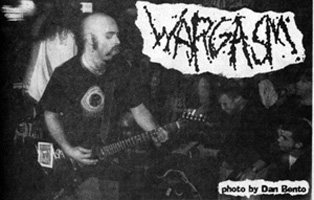 Derek Riggs
Derek Riggs
by Scott Hefflon
Do you live in London or in the country?
I currently living in Cumbria, it’s in the middle of England, up North. Actually, it’s quite close to the border of Scotland, so I guess it’s nothing like the middle of England, is it? I meant middle as in side to side… It’s quite countryside. I used to live in London, I lived there for about 20 years. Then I moved to Brighton, directly South, right on the coast. And now I live in Cumbria, about 500 miles North of London. I’ve only just moved. I realized living on the shore wasn’t good for my health. It was declared the dirtiest beach in Britain while I was there, and England has the dirtiest beaches in Europe… It’s always really windy on the south coast, because all the wind that comes into England comes from the southwest, so it hits that area full belt. Every time I went for a walk by the sea, I would come back with all the glands in my neck swollen up. I lived there three or four years, then I moved here just before Christmas. I rent from a friend of mine, and I kind of took over the loft. But I’m thinking of moving again because I’m sick of the cold and the wind, and I kind of fancy living in the desert…
 Do you miss living in a metropolitan area?
Do you miss living in a metropolitan area?
No, London’s horrible. It’s dirty and noisy and smelly and nasty. And it rains a lot. I went to London the other week, and everyone was completely paranoid… I was in Shepherd’s Bush, and I was walking around looking for a bus stop to get out and get to the center of London, and everyone ran away from me. I’d ask where the bus stop was, they’d say they don’t know and look at the ground and walk away quickly. I felt like the bad guy in a Western where mothers drag their children off the street…
Do the remote locations help your artwork, or hinder you getting clients?
I get most of my work through the Internet. People hunt me down that way. I’m trying to get a website together to use as a portfolio. Also, I thought I could sell posters of some of my work. I have a friend who started a poster company to help me out, and she’s going to be selling the work mostly online. Once I get the website working, sometime soon, people can go to derekriggs.com and email me through that.
You’re a .com, not a .co.uk?
I’m a .com, mate.
To switch gears, tell me how long you’ve been doing art and how you started.
I’ve been doing it since the start, really, and I wasn’t really encouraged. Most people thought I was a little weird.
 Have you always drawn fantasy?
Have you always drawn fantasy?
Pretty much, but different aspects of it. I was into surrealism for a while, and I did comic books and stuff, and then science fiction. I always experiment with things, and a lot of things don’t work.
Did you go to art school?
Yeah, I got thrown out. I went for a year and a term and then they asked me to leave. It was a school in Coventry where I grew up. It is in the middle of England, both top to bottom and side to side. I took some graphic design courses because fine art seemed a little undirectional. But I wanted to do illustration. The government closed the course down about a year after I left.
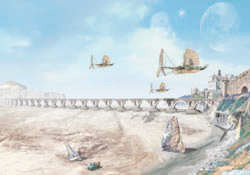 What’d you get thrown out for?
What’d you get thrown out for?
Mostly for disagreeing with them and making a nuisance of myself. Rubbish, basically.
What did you do after leaving art school?
I was a photographic printer for a while trying to get illustrations together. Then I started doing record covers, jazz covers, believe it or not.
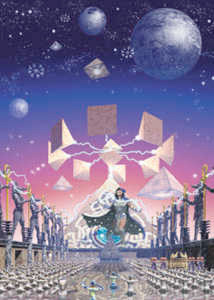 How’d you get your first assignment?
How’d you get your first assignment?
I just wandered around record companies with my portfolio. In those days, there were only five or six record companies here. We’re talking late ’70s/early ’80s so there were just the big ones: EMI, CBS, WEA, and so forth. I sold a couple here and there… The people at EMI said they’d been there ten years and I was the first person to just walk though the door with a portfolio. The whole market was wide open. The first couple assignments were jazz covers for EMI. They were kind of simple, a mixture of surreal and fantasy, and not very good.
How old were you at the time?
I don’t know, maybe 20, 21.
How’d you transition from jazz to being the exclusive cover artist for Iron Maiden?
Because the record companies were all the majors – there weren’t any independent labels as such, though Led Zeppelin started their own label, and that was kind of revolutionary at the time – there wasn’t really any separation between doing a jazz cover and a heavy metal cover. I spoke to the same people… I did some work for a reggae band, and some private commissions for a few well-known people…
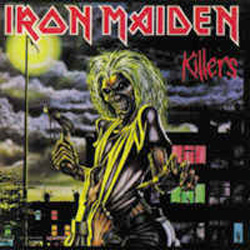 Who?
Who?
I sold a couple of pictures to Kate Bush and her family. They were portraits, and they weren’t bad. I’ve done them for years… I also did some rock and disco covers because the same art directors were doing everything.
Were you a starving artist?
I was freelance and I was paying rent, and I wasn’t doing anything else for income…
Did you do stuff you were embarrassed by for the money?
Well, yeah, but you get on with it and keep the wheels turning. Luckily, I can paint very fast, because a lot of the time the deadline was, like, three days. There was a disco group I did the cover for, and they called up and said they wanted the back cover as well by the next day. So I went home and did it.
Did you ever do any kind of ad work, billboards, set design or anything?
No, it was mostly album covers. It was the place that paid the best and I could get assignments quite easily. And I understand that market. You have to go where you have a kind of intuitive sense of what’s required. Like the science fiction book market: I can do really weird science fiction pictures, but I guess it’s not what the market requires. Some people have a better feeling for that…
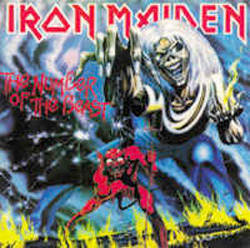 Why do you think that is?
Why do you think that is?
Well, some of my ideas get off the wall… And the art requirements are very tight. I tried to work out why an art editor wants one style but not another, but when you look at it and you can’t tell the difference… I’m a trained artist, and I often can’t see any significant difference. Yet one artist gets a lot of covers, and another gets none. I used to work with agents, and one of them was the biggest in the field of book covers, and even the agents didn’t really know…
How did you hook up with Iron Maiden and become THE cover artist for them?
Well, the art director at EMI had some of my work on his wall, and Rod Smallwood, Iron Maiden’s manager, saw them and liked them. He was looking for an artist with a strange style, and he took a shine to those not-very-good-but-rather-distinctive jazz covers. He asked to see my portfolio, so I stuffed a bunch of paintings into this big, wooden portfolio and dragged it down to the recording studio where they were putting together their first album. The picture of Eddie that became their first album cover was a picture I did a year and a half before they ever saw it. He wasn’t called Eddie back then. I used to give my paintings silly titles because everyone else’s were terribly meaningful. They’d paint pictures of muscular fat guys with swords and call them “The Last of the Few” or something… So I had this picture of a skull thing in a tee shirt with hair sticking up – he didn’t have long hair at the time, he had punky hair because it was the late ’70s when punk was going on. The picture was called “Electric Matthew Says Hello.”
Did the original have the same night-in-the-city thing to it?
Yeah, I got the idea for that from H.P. Lovecraft who said it was easy to make something scary when you’re in the middle of Transylvania or something and there’re smoke and bats everywhere, but the real art of horror is to make it scary on the street you live on. I thought it was a cool idea, so I stole it. So the background is a street I used to live on in London. Or one of them, anyway – I moved around a lot. I always move around a lot. It’s the gypsy in my soul.
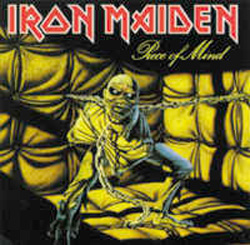 How did the character get the name Eddie?
How did the character get the name Eddie?
Well, he had the skull face and the lights in his eyes, and they used just his head for the logo. They called it Ed because they just had his head. Like, “We just got ‘is ‘ed.” So that was that.
What was the first cover you did from scratch for Iron Maiden?
The first thing that was released was a single, just before the first album. It was for “Running Free,” and they wanted something sinister lurking in the background, but they didn’t want to give the face away. Then came the “Sanctuary” single with the picture of Eddie with a knife hanging over Margaret Thatcher’s body lying on the ground. She was called The Iron Woman because she was fucking up England’s economy quite extensively. And there was another single called “Women in Uniform” that had Margaret Thatcher in military gear and Eddie and two women.
Has Iron Maiden always used backdrops and masks and giants puppets and stuff?
Yeah, I painted the first Eddie backdrop – actually the first three or four – and then I managed to get out of doing them because they were horrible to have to do. You end up getting shipped across London to some lonely, cold, wet warehouse with sheets of canvas and a bucket of paint.
Were the early Eddie masks actually Eddie, or were they, like, converted Phantom of the Opera or monster masks?
No, they were specially made. They had a few of them. Some of the masks were made by this bloke who made props for television, and a large puppet was made by a guy who did giants for theater productions.
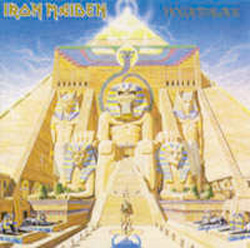 Not to get into the legalities of it, but did you design the masks and dolls and stuff, or did you get paid, seeing as it was your character?
Not to get into the legalities of it, but did you design the masks and dolls and stuff, or did you get paid, seeing as it was your character?
Well, I sold the rights to the paintings when I sold the paintings, and I got royalties for all the merchandise.
Did you have any idea Eddie was going to take off the way he did?
Actually, yeah, I did. When I did the first painting, before I met Iron Maiden, I looked at it and said, “That’s going to make me rich and famous.” Then I said, “Don’t be silly,” and I stuck it in a drawer.
Were you still freelancing when you first started working with Iron Maiden?
I was freelance the first few albums, but then they put me under contract, offered me royalties, and I had to work exclusively for them. So I did that for quite a while. Actually, I didn’t mean to do it that way for as long as I did, but I got ill, and I couldn’t really work that much. I got M.E., chronic fatigue syndrome. Yuppie flu, but I ain’t a yuppie and it wasn’t the flu. I had it about ten years before I worked out what it was and what was causing it. I had mercury in the water and fillings in my teeth, and it disagreed with me. It turns out I’m very susceptible to heavy metal poisoning, which is quite ironic. So I worked exclusively for Iron Maiden because they were paying a lot and it was about all the work I could do before I collapsed. It was about The Number of the Beast time period that I got heavy metal poisoning, and it was all downhill for about ten years.
When did you start freelancing again?
Just a couple years ago. They bought the remaining rights off me because they wanted to use other people, and I wanted to go in other directions. You can only paint one character for so long before you get sick of him.
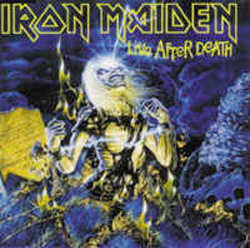 What was the last cover you did for them?
What was the last cover you did for them?
I did one recently for a live album. They’ve been using other people, and they haven’t been doing very well. It was a picture of Eddie with a crowd of monsters behind him. I don’t know if it’s been released yet… I’m doing some stuff for Gamma Ray and I just finished some things for Stratovarious, and I’m working for a Spanish band called Genu. They’re quite good, actually. They sound a bit like Jethro Tull.
You also did Gamma Ray’s Powerplant, right?
Yes. This one is further in that direction.
How long does it take you to do a painting?
Sometimes it takes overnight, sometimes it takes months. Sometimes I think a piece will be hard, but it all falls together. Other times I think, “I can do this. This is a dawdle,” and I can’t bloody do it. Like the last Iron Maiden piece that I absolutely failed to finish… Everything I tried died, nothing worked, what I sent them they didn’t like.
The symbol that’s appeared as your signature on most of the covers: what’s it mean?
It’s my initials – a D and an R – placed back to back, and I stuck these other things on as decoration, really. Just to make it look weird, kind of mystical… I’ve modified it since then. It’s now just the D and the R with a circle around it. And sometime I don’t sign my pieces, just so people will sit around and try to find the signature when it’s not there at all.
There’s only been one photo of you in the booklets that I can remember. In Piece of Mind, producer Martin “Black Knight” Birch and you, Derek “Dr. Death” Riggs, standing there in armor…
They have two or three photos of me in total. I usually just try to stay out of the way…
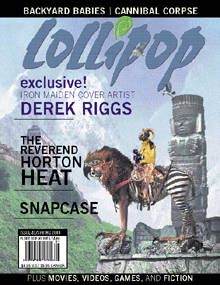
Tell me about the piece that’s on our cover.
I was experimenting, playing. The piece is called “Strange Rider.” I got this free CD from a magazine of the San Diego Zoo, I think, and it had a huge library of photos of animals. So I started montaging them together… For a while, I was painting and doing computer art, then one day, I didn’t have enough room in my studio to do both, so I had to make a choice. So I kicked out the painting, because I was quite sick of it. If you think about it, most of painting is spent waiting for paint to dry. It sounds like a bad joke, doesn’t it? I’ve spent most of my professional life waiting for paint to dry. What would take days to paint can be done in seconds on the computer. It takes the pain out of it, and you can get on with what you should be doing. Consequently, you usually get a better end result because you’ve spent most of you time making the image. I’m not a fine artist. I don’t sell canvases covered in oil, I sell images other people use as covers, posters, and such. It’s the end result that’s important, not fluffing a bit of paint around.
And the file is already digital, so it can be resized or adjusted by the client to suit their needs: posters, CD booklets, minis for ads, low res for the web… How’d you do it before?
Most of the original paintings are about the size of the album covers. About an inch bigger because it had to be folded around and glued. They used to photograph it to slide, then use that.
Where are all your original canvases for Iron Maiden covers?
All the Iron Maiden work was done with acrylic paint on illustration board. They all belong to Iron Maiden now. I think they’re in Steve Harris’ house. When I sell artwork, I sell all the rights with it so they can use it for whatever they want. They pay me what I ask for, and then they never hear from me again unless they want another piece. Album covers just don’t work any other way… People get pissed off when they’re chased around by artists who write into the contract that the image can’t be used for this or that…
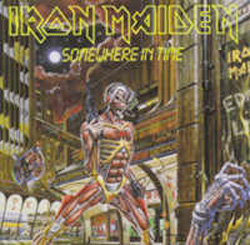 How much does a commissioned piece cost? Is there a rule-of-thumb?
How much does a commissioned piece cost? Is there a rule-of-thumb?
About 2000 pounds. If it’s simple, I can usually do it for less…
And if it’s a piece you did for yourself, like the piece I used for the cover of this issue...
I don’t really have a lot of pieces in my archives. My portfolio doesn’t have a lot of stuff in it that’s never been used. The fellow on the horse – or “the thing on the thing overlooking the stuff” as you so eloquently put it – was kind of a rarity… Usually I work from the briefs I’m given.
Do people get really specific, or do they let you run with ideas wherever they take you?
It really varies… Bruce Dickinson asked me to do a cover for his live solo record, a glove puppet called Eddie-Son. So I did this really cool 3-D model, and then he came back and said he wanted something else. I don’t think he used it, but he paid for it and he owns the rights to it now. Sometimes, people come to me with a title and just ask what I think, where I’d like to go with it. Other times, like Stratovarious, gave me a straightforward concept, and they’d already done the sketch. They wanted the two sides, with the two kinds of cities, and dolphins jumping through the symbol for eternity. I suggested we make one dolphin gold and one dolphin lead, and other ideas came out as we went along. They asked me to stick some planets in the sky, and to contrast the dolphins in the water on the heaven side, I suggested some dead fish in an oil slick on the Earth side. The details evolve and ideas lead to one another as stages of the illustration go along.
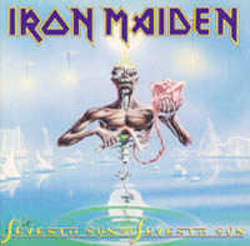 When you were working on illustration board and it wasn’t as easy as deleting a layer in PhotoShop, did anyone ever ask you to remove a detail?
When you were working on illustration board and it wasn’t as easy as deleting a layer in PhotoShop, did anyone ever ask you to remove a detail?
Yeah, on Somewhere in Time, the big city scene, they wanted it to look more Blade Runner than Star Wars, and up in the sky, I had the U.S.S. Enterprise and a few other well-know starships, and they made me take them out so they wouldn’t get sued. But I stuck Batman standing on a ledge on the back sleeve. That was about three years before the Batman movie came out. And if you look at the front window of the building, there’s a reflection of a street sign across the road that if you read backwards says, “This is a very boring painting.” I like to stick any old rubbish in there… I managed to get Mickey Mouse in there one time without getting caught. It was on the single for “Twilight Zone.” There’s a woman sitting in front of a mirror with Eddie appearing in the reflection behind her, and behind a photo of Eddie on the dresser, Mickey Mouse is poking his head around at her. That’s part of the problem with CD covers versus album covers, all those details died. It’s very hard to do that sort of thing and make it visible.
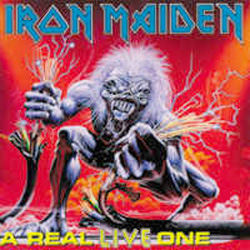 Have you done anything huge?
Have you done anything huge?
I did those first couple murals or backdrops for Iron Maiden… But I don’t like painting on a large scale because it’s boring. The bigger you paint, the longer it takes to simply cover the space, and the less time there is for the interesting bits. You spend five days painting the sky blue… But now that I do everything on computer, everything’s a separate layer, a separate file. So when someone buys an image, they can dismember the elements and use them separately or recombine them. Stratovarious can use the dolphins and the infinity symbol alone, and I did a version that had the background of a building instead of the two cities, but in the reflection of the windows, there was the ocean and the sky. I did about eight variations for posters they can use. I didn’t charge them much because it was mostly recombining the pieces I already had, plus a few other ideas I’d had that I didn’t use for the main illustration.
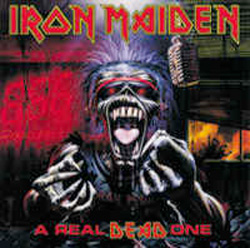 With a cover like The Number of the Beast, did anyone ask you to take out a specific little demon or anything? And if they did, did you, or did you argue?
With a cover like The Number of the Beast, did anyone ask you to take out a specific little demon or anything? And if they did, did you, or did you argue?
No one’s really asked, but if they asked, I’d take it out. It’s their cover and they have to live with it, and it’s them that’ll get sued… That’s why I like the original idea to come from the band. Unlike some designers who think they’re so clever, they know all the answers, and they try to talk people into things they don’t really want. And nine times out of ten, they’re bad ideas because the designer didn’t really understand the market. The band has to live with the picture long term, and if the fans think it’s a shit picture, they blame the band. A few times I’ve been asked to take out a detail that’s a bit dodgy or cover up a nipple, but I just take it out because what’s the point?
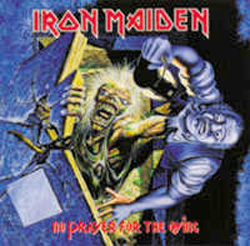 Do you listen to the music of the band you’re doing the cover for while doing the cover?
Do you listen to the music of the band you’re doing the cover for while doing the cover?
No. Most of the time the record isn’t ready – the band’s still in the studio while I’m working on the cover. Usually I listen to nothing while working… When I’m doing the easy bits I sometimes listen to music, but when I’m trying to concentrate, it gets on my nerves, it’s too distracting. I tend to paint late at night, and the same goes for computer art… I tend to be rather nocturnal anyway.
Have you ever gotten sucked into an illustration, your imagination running away wild, to the point of being dangerous?
Only with Somewhere in Time. I worked on that for so long, I started hallucinating. I had to stop for two weeks because I wasn’t doing any work. I just sat in front of the painting, imagining where all these little characters were going and what their lives were like. I don’t have nightmares and then paint them, as some people might think, it all starts and ends on the canvas. Usually.
www.derekriggs.com

